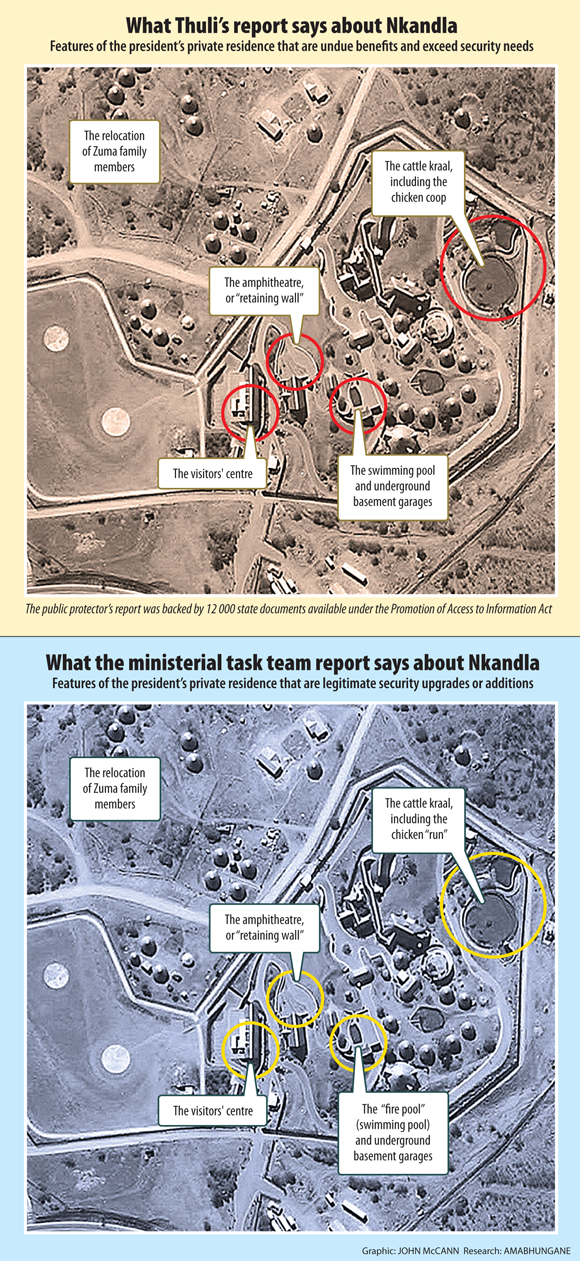At a progress meeting in June 2011, Nkandla architect Minenhle Makhanya promised to brief President Jacob Zuma on the impending construction of a "fire pool" to be built at his private home, documents obtained earlier this year by the Mail & Guardian show.
Why Zuma would concern himself with something as banal as a facility to store water for fire fighting was of no concern to the security cluster ministers, who instituted an investigation into spending at Nkandla and released it to the media on Thursday.
Or perhaps it was, but their terms of reference did not stretch far enough for the ministers to contact the president for clarity on the matter – or for clarity on the myriad upgrades at his private home, from which he supposedly derived no personal benefit. So they say.
Nevertheless, the "fire pool" is being used as a swimming pool, but its real purpose, as claimed by the ministers on Thursday, is to store water to fight fires.
The explanation could not be further from the finding that sources say are in the public protector Thuli Madonsela's provisional report on the same matter, details of which were published by the M&G last month. It describes the R2.8-million "fire pool" as an undue benefit to the president, for which he must repay the state.
The implication in Madonsela’s report is that the "fire pool" is simply a swimming pool.
Indeed, the chief director of strategic planning in the South African National Defence Force, Vejay Ramlakan, said on Thursday that the pool was being used for swimming.
Unfortunately, the engineers who Ramlakan claimed were responsible for the "fire pool" to be built were not at Thursday's briefing to explain its dual purpose.
Costing
But what was clear was that the ministerial task team had costed the pool under "security", along with the paving, helipads, cattle kraal and other items. Then there is the matter of the amphitheatre, which, it was revealed, is unlikely to be used to stage performances any time soon – it is merely a four-metre high wall constructed to "secure the ground" (from collapsing, one could infer.)
The first and most glaringly obvious contradiction between the two reports is that the task team report exonerates Zuma but Madonsela's provisional report finds that he derived "substantial benefit" from the pool and other features.
The incongruities between the two reports go deeper and are revealed by the contradictions in the versions put forward by the ministers themselves.
On Thursday, the task team placed much of the blame for over-expenditure on former senior public works officials. But the security cost allocations (without the "professional fees" that totalled R48.4-million) were approximately R158-million, according to the ministers' report.
Of that total, R107.3-million was spent on the police's and SANDF's "departmental operational needs", which included accommodation, medical facilities, pavilion, helipad, roads and earthworks.
But Ramlakan blamed the exorbitant costs on the "engineers" appointed by the public works department – a statement that ignores that it was his department's recommendations that necessitated the costs in the first place.
According to the documents obtained by the M&G earlier this year, justifying the cost overruns, public works said that the police issued a "revised" scope of works at the last minute. This apparently had public works appointing more service providers – for the supply of bullet-resistant glass, a generator and prefabricated structures – with "emergency" permission obtained from more senior officials. Formal permission was again sought months after procurement.

What the ministerial report on Zuma's homestead missed
The interministerial task team report contains details of the Nkandla project as well as scathing criticism of the way in which public money was managed. But it is sorely lacking in detail in parts, and the as yet unidentified team seems to have missed some rather crucial details that are easily accessible in the documents that were available to the investigators, and have since been made public by the Mail & Guardian, some of which have been captured in articles over the past four years.
These include:
- The report finds that contractor Bonelena "employed foreign nationals in the project who were not vetted". But it does not note that Bonelena also employed four individuals "with guilty verdicts for criminal offences". In a letter dated September 29 2011, the company was told that those individuals, all with South African identity numbers, "are therefore no longer allowed to work in this project";
- The report notes that then-minister of public works Geoff Doidge and deputy minister Hendrietta Bogopane-Zulu "presided over site meetings and in some instances interacted with contractors", something that "raised uneasiness with the involvement of the executive in the project". But it fails to note that Public Works Minister Thulas Nxesi (who commissioned the report) also received correspondence and was involved in negotiations with suppliers – and that correspondence was addressed to the office of President Jacob Zuma; and
- An "explanatory note" is attached to the report to clarify matters raised "after the task team report was presented". These include issues such as a "fire pool" (which looks a lot like a swimming pool) and a retaining wall (which appears to function just like an amphitheatre), as well as a luxurious cattle kraal.
But, the report itself makes no mention of any of these three features – features that are likely to be presented in the public protector’s report as carrying undue benefit for Zuma. – Phillip de Wet